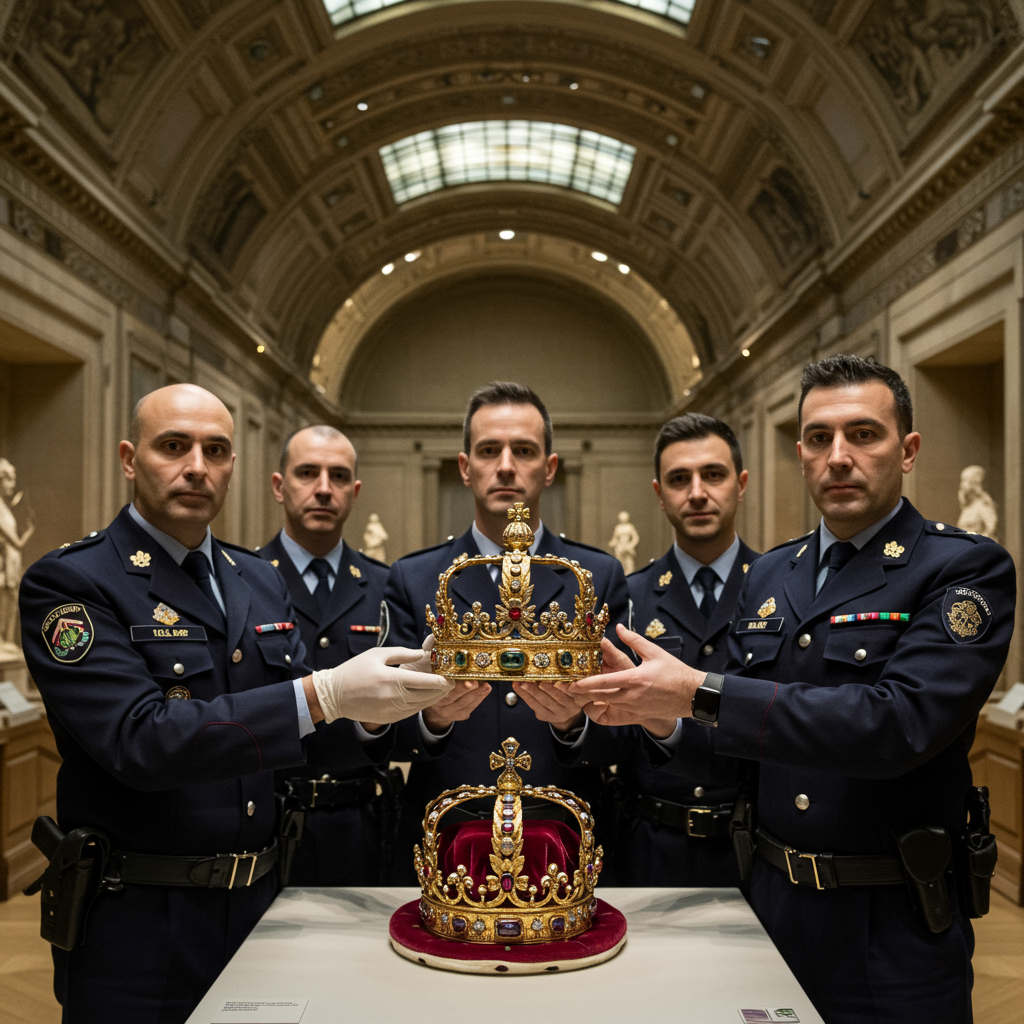The world watched in disbelief as an audacious Louvre heist unfolded in Paris on Sunday, October 19, 2025. In a lightning-fast operation, thieves targeted priceless Napoleonic crown jewels, executing a daring daylight robbery at the planet’s most-visited museum. This brazen art crime sparked a nationwide manhunt. Yet, within days, French police announced significant breakthroughs, including the recovery of one major artifact and the arrests of several suspects. The incident thrust Paris museum security into the global spotlight, prompting urgent questions about the protection of invaluable cultural heritage.
A Daring Daylight Strike: How the Louvre Heist Unfolded
The meticulously planned Louvre heist began at 9:30 a.m., a mere half-hour after the museum opened its doors to visitors. Four masked perpetrators, operating with astonishing precision, initiated their assault on the Louvre’s Seine-facing façade. Their method was audacious: a truck-mounted extendable ladder was deployed. This allowed two of the thieves, disguised in construction workers’ yellow safety vests, to scale the building and reach a second-floor balcony.
By 9:34 a.m., they had breached a window in the Apollo Gallery. Using an angle grinder, they cut through the panes, gaining entry to the hall. This gallery, home to the Crown Diamonds, is located just 250 meters from Leonardo da Vinci’s iconic Mona Lisa. Inside, the thieves swiftly smashed two high-security display cases. They knew exactly what they wanted, demonstrating a high level of expertise.
The museum’s alarm system was triggered at 9:37 a.m., but the thieves were already executing their escape. Within one minute, by 9:38 a.m., they descended the ladder and sped off on two motorbikes. In their hasty departure, one invaluable piece, the emerald-set imperial crown of Empress Eugénie, adorned with over 1,300 diamonds, was inadvertently dropped outside the museum. It was later recovered, albeit reportedly broken. Police arriving minutes later found several tools, including angle grinders, a blowtorch, gasoline, gloves, and a walkie-talkie, discarded at the scene. The entire operation was a “four-minute operation” inside the museum itself, with the broader heist lasting less than eight minutes from entry to escape.
The Stolen Legacy: Priceless Napoleonic Jewels Targeted
The target of this high-stakes Louvre museum robbery was a collection of eight objects. These were primarily linked to 19th-century French royalty. The stolen items held “inestimable heritage and historical value,” far surpassing their market price. Among them were:
Sapphire Diadem, Necklace, and Single Earring: Part of a matching set associated with French queens Marie-Amélie and Hortense.
Emerald Necklace and Earrings: Belonging to Empress Marie-Louise, Napoleon Bonaparte’s second wife.
Reliquary Brooch: A historically significant piece.
Empress Eugénie’s Diadem: An intricate and highly prized imperial ensemble.
- Empress Eugénie’s Large Corsage-Bow Brooch: Another exquisite component of her imperial set.
- abcnews.go.com
- www.eastidahonews.com
- apnews.com
- www.yahoo.com
- www.pbs.org
While Empress Eugénie’s magnificent crown, featuring 1,354 diamonds and 56 emeralds, was recovered, its damaged state underscored the violent nature of the theft. The remaining seven items, however, vanished. This collection represents a direct link to France’s imperial past, making their loss a profound blow to national heritage. The precision with which the thieves chose their targets suggests an intimate knowledge of the collection’s layout and value.
Persistent Vulnerabilities: Louvre Security Under the Microscope
The Louvre heist brought long-standing concerns about Paris museum security to a critical juncture. Staff unions had repeatedly voiced worries about overwhelming crowds and chronic understaffing. These issues, they argued, strained security measures, leading to pressure points where construction zones, freight routes, and visitor flows converge. A staff walkout in June, delaying the museum’s opening, highlighted these very complaints.
Culture Minister Rachida Dati acknowledged that security measures had been enhanced in recent years. These upgrades included new-generation cameras and perimeter detection systems. However, critics like French teacher Magali Cunel expressed disbelief. She questioned how a lift could be brought to a palace-museum facade “unchecked,” allowing jewels to be stolen in broad daylight. The incident starkly underscored that while marquee works like the Mona Lisa are protected by bulletproof glass, security is not uniformly robust across the Louvre’s vast collection of over 33,000 objects.
This crown jewels theft is not an isolated incident in France. The previous month alone saw significant robberies: gold from the Musée de l’Histoire Naturelle and valuable porcelain from the Adrien Dubouché museum. Even the Jacques Chirac Museum was hit twice in three days. The Louvre itself has a history of high-profile thefts, famously the 1911 disappearance of the Mona Lisa and the 1976 theft of King Charles X’s jeweled sword through the very same window used in this recent heist. These repeated incidents highlight systemic vulnerabilities within French cultural institutions.
Swift Action: The Investigation and Arrests
The response to the Louvre heist was immediate and robust. Over 100 investigators from a specialized police unit, focusing on armed robberies and art crime, were mobilized. Forensic teams meticulously swept the crime scene and adjoining access points. They collected a wealth of evidence, including 150 trace samples of DNA and fingerprints from a helmet and glove left behind.
Crucial CCTV footage from the Denon wing and riverfront emerged by October 23. It depicted two suspects exiting the Apollo Gallery via what appeared to be the mobile cherry picker. They were then seen fleeing on motorbikes. One wore a motorcycle helmet, while the other donned a balaclava and yellow construction vest. The investigation moved quickly, leading to the arrests of two men on October 25 and 26. One suspect was apprehended at Paris Charles de Gaulle Airport attempting to board a flight to Algeria. The second was caught preparing to travel to Mali. These rapid arrests showcased the efficacy of forensic evidence and surveillance in high-profile cases.
Despite the arrests, French authorities emphasized that the nationwide manhunt for the remaining perpetrators continued. The critical objective: recovering the unlocated Napoleonic jewels. Interior Minister Laurent Nunez praised the investigators’ “tireless” work, reaffirming confidence in their efforts. However, the premature leak of arrest information caused concern among prosecutors, who feared it could impede the ongoing investigation. The incident also quickly spilled into the political arena. Far-right leader Jordan Bardella lambasted President Emmanuel Macron’s government, calling the Louvre museum robbery an “unbearable humiliation for our country.”
The Enduring Mystery: What Happens to Stolen Art?
Experts in art crime and recovery express a grim outlook regarding the unrecovered crown jewels theft items. Christopher Marinello, founder of Art Recovery International, believes that while the criminals may be caught, finding the jewels intact is unlikely. Their extreme recognizability makes selling them on the open market “incredibly difficult.” Erin Thompson, an art crime professor, suggests a strong possibility that the artifacts will be melted down or broken into smaller, less conspicuous components. This process, she explains, effectively “erases their provenance,” allowing them to be sold as new jewelry without attracting attention, potentially even in regular stores.
However, this destruction comes at a steep price. It significantly devalues the items, destroying their historical worth. The smaller components would fetch only a fraction of their original value. Robert Wittman, a former FBI art crime investigator, notes that “the real art in an art heist isn’t the stealing, it’s the selling.” He remains skeptical about the thieves’ ability to monetize such high-profile goods without being caught. The age and quality of the diamonds mean they are likely ungraded, unsuitable for open market or auction house sales. While some suggest thieves might “sit on” the jewelry for years until suspicion cools, the challenge of finding skilled individuals willing to recut historical gems without asking questions remains.
Adding to the challenge, the Louvre jewels were reportedly not privately insured. This means no “no questions asked” rewards from insurance companies, which can sometimes aid in recovery. While government rewards for information could expedite investigations, France has not yet offered such an incentive. As time passes, the prospects of recovering these historic Napoleonic jewels intact continue to dim, a stark reminder of the devastating impact of art crime on global heritage.
Frequently Asked Questions
How was the Louvre heist carried out, and what specifically was stolen?
The Louvre heist involved four masked thieves who executed a “seven-minute operation” on October 19, 2025. They used a truck-mounted extendable ladder to reach a second-floor window on the Louvre’s Seine-facing façade. Disguised as construction workers, they breached the window with an angle grinder, then smashed display cases in the Apollo Gallery. Eight priceless Napoleonic jewels were targeted, including sapphire and emerald sets belonging to 19th-century French queens and empresses, and Empress Eugénie’s diadem and corsage-bow brooch. One item, Empress Eugénie’s emerald-set imperial crown, was recovered outside the museum, though it was damaged.
What steps did authorities take to investigate the Louvre museum robbery and apprehend suspects?
Following the Louvre museum robbery, French authorities launched a massive investigation involving over 100 specialized police officers. They meticulously collected forensic evidence, including DNA, fingerprints, and discarded tools like angle grinders and a walkie-talkie. CCTV footage was crucial, capturing the thieves’ entry and escape on motorbikes. Within a week, on October 25 and 26, two suspects were arrested. One was apprehended at Paris Charles de Gaulle Airport attempting to flee to Algeria, and the other while preparing to travel to Mali. The swift action demonstrated robust law enforcement response to this high-profile art crime.
What is the likely fate of the unrecovered crown jewels, according to experts in art crime?
Experts in art crime and recovery believe the unrecovered crown jewels theft items face a grim future. Due to their immense historical value and extreme recognizability, selling them intact on the legitimate market is virtually impossible. The consensus is that they will likely be broken down, melted, or recut into smaller, less identifiable components. This process destroys their historical provenance and significantly devalues them, reducing their worth to a mere fraction of their original value. While some thieves might “sit on” the jewels, experts suggest full recovery is unlikely, and finding them intact would be a rare success.
Conclusion
The Louvre heist of October 2025 stands as one of Europe’s most audacious art crime events in recent memory. It underscored the persistent vulnerability of even the world’s most iconic cultural institutions. Despite rapid police action leading to arrests and the recovery of a significant artifact, the bulk of the priceless Napoleonic jewels remain missing. This incident serves as a stark reminder of the ongoing challenges in safeguarding global heritage. The political fallout and ongoing calls for reinforced Paris museum security highlight the profound impact such thefts have, not just on cultural property, but on national pride and policy. The investigation continues, aiming to bring all perpetrators to justice and, against expert odds, hopefully recover the full extent of France’s stolen imperial legacy.



